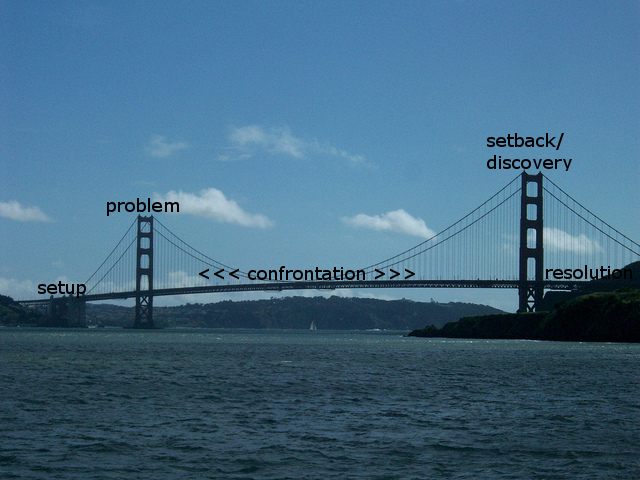Does your story sag in the middle? Do you feel like you’re plowing through boring scenes just to get to the cool ones? Is your protagonist wandering around aimlessly, looking for the climax?
It’s not enough to have all the major events written down in a neat little list – what you need is structure.
An important distinction
Structure is not formula:
- Formula is like having the same floorplan over and over.
- Structure is a floor, walls and roof: you can organize them into whatever floorplan you like – but you can’t build a house without them.
Structure is the ebb and flow of tension and discovery that keeps you readers moving through the story. Structure helps you:
- Keep the pace up
- Know what’s important and what isn’t
- Understand when to start and end the story
The following is a time-honored plot structure endorsed by Syd Field and others.
Structure of a Plot
Setup
In Act I, or the beginning of your story, you introduce the hero. We learn what he cares about and decide if we like him. This part should be relatively short. Keep the backstory to a minimum: it’s only an introduction.
Examples:
- Bilbo celebrates his eleventy-first birthday
- Luke buys some used droids
- Passepartout starts a new job under Fogg
Problem
Within the first or second chapters, introduce the problem. Syd Field calls this Plot Point 1, which hooks the action and spins it into the next act. James Scott Bell calls it the first “pillar” of your plot “bridge,” or the first Door of No Return. This usually happens in a single scene – maybe at the end of the same scene you used to introduce the character.
Examples:
- Frodo learns an evil something is coming to the Shire in search of Bilbo’s old Ring.
- Luke’s aunt and uncle are killed, and he’s got the droids their killers are looking for.
- Passepartout’s new boss bets some friends he can circumnavigate the globe in 80 days. Starting tonight.
Confrontation
Now we’re in the middle, or Act II of your story. This is the biggest chunk of the book. Your hero will face a series of obstacles, each more difficult than the last. As he overcomes each obstacle, the plot thickens, the tension increases, and the stakes are raised. In other words, new developments reveal that the hero stands to lose (or gain) even more than he originally thought.
Your hero should be getting more and more desperate; the pace should get quicker and quicker.
Examples:
- Frodo and his friends face wraiths, orcs, trolls, giant spiders, etc.
- Luke saves a princess, escapes the Death Star, loses his mentor, etc.
- Passepartout and co. fight through bad weather, savage attacks, etc.
Setback/Discovery
Plot Point 2, the second pillar of the bridge, or the second Door of No Return. This is the worst setback and/or the major discovery that signals the climax. Your hero is now either armed with new information that leads him to a final showdown with the villain, or has been brought to his lowest point – he is betrayed, or he’s been shot, or the girl he’s been trying to save all this time gets killed, etc. The villain believes he has won.
It’s at this point the hero must make a decision. The ultimate decision.
Examples:
- Setback: an army of orcs between Frodo and MountDoom. They disguise themselves as orcs. Decision: Frodo decides whether to keep or destroy the Ring.
- Setback: Luke, now a rookie rebel fighter, is the last armed fighter left against the giant space station. Decision: Whether to trust the computer or the Force.
- Setback: After being detained, Fogg and co. believe the game is lost. Decision: Fogg decides to marry the girl he loves.
Resolution
The End, or Act III. The climax and conclusion are the results of his ultimate decision. Does he win or lose, learn a lesson, live to fight another day?
Examples:
- We find out who survived, who married whom, and who leaves Middle Earth.
- We find out if Luke succeeds or fails and what that means for the Rebel Alliance.
- Passepartout sets out to find a priest to do the marrying, when he discovers they arrived in town a day early – and we find out if they make it in time.
So there you have it. Just follow the bridge to get safely across to happily ever after.
—



